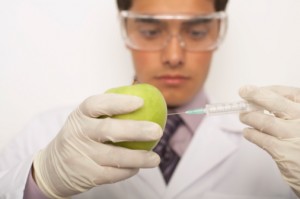GMOs: What Are They and Why Are They Harmful to Your
Health?
Genetically modified organisms, or GMOs, are not as new as you might
think. Both animals and plants have been modified for hundreds
of years through a process called selective breeding. It
wasnít until the rise of genetic engineering that we saw these
organisms getting altered in ways not possible before.
Hereís a somewhat staggering statistic: By 1999, over two-thirds of processed food within the United States contained genetically modified ingredients. So, letís take a closer look at GMOs and why it sparks so much debate.
Science Steps In
Todayís scientists have a much more advanced understanding of genes,
and because of this the most common type of modern genetic
modification is called transgenesis, which involves taking DNA from
organisms and directly transplanting them into another. These
transgenic organisms are built with the intention of gaining
desirable traits from other species, whether itís from an animal to
another animal, a plant to a plant, or between plants and animals.
 One
example of transgenic species that you may have seen (and probably
eaten) is frost-resistant strawberries. These strawberries
received genes from fish that were well adapted to cold waters in an
effort to extend the growing season. This didnít lower the
freezing point enough, however, so researchers are now adding
frost-resistant bacteria instead; but thatís opening up another can
of worms.
One
example of transgenic species that you may have seen (and probably
eaten) is frost-resistant strawberries. These strawberries
received genes from fish that were well adapted to cold waters in an
effort to extend the growing season. This didnít lower the
freezing point enough, however, so researchers are now adding
frost-resistant bacteria instead; but thatís opening up another can
of worms.
Genetically Modified Pets?
Another example of a GMO is GloFish. You might have noticed
these little guys when you visited the local pet store Ė their
brightly colored, fluorescent bodies are hard to miss. The
GloFish, which is actually a patented and trademarked animal, is the
result of scientists adding the fluorescent proteins from jellyfish
to a normal Zebrafish. By adding these special proteins, the
fish are brightly colored and light up even more under a black
light, similar to jellyfish at the aquarium. Over 200 million
of these ornamental fish have been sold in the United States alone,
and the numbers keep rising. With such a large popularity,
whatís keeping other engineers from trademarking additional
lab-created pets?
Dangerous Foods
Most processed food in the United States contains some genetically
enhanced
 ingredients,
including meats, cooking oils, milk, fruits and vegetables.
The potential dangers vary and usually depend on what the
modification is. The dairy industry uses a growth hormone that
produces more milk, but makes the cows more susceptible to disease.
Treating these diseases with antibiotics means that those
antibiotics will end up in the stomach of you and I, the consumer.
This gradual buildup of antibiotics will cause us to develop a
resistance to our own antibiotics, and might even spur allergic
reactions. If thatís not enough to deter you, consider this:
the growth hormone, rbGH, has been shown to stimulate the production
of IGF-1, which is a cancer accelerator.
ingredients,
including meats, cooking oils, milk, fruits and vegetables.
The potential dangers vary and usually depend on what the
modification is. The dairy industry uses a growth hormone that
produces more milk, but makes the cows more susceptible to disease.
Treating these diseases with antibiotics means that those
antibiotics will end up in the stomach of you and I, the consumer.
This gradual buildup of antibiotics will cause us to develop a
resistance to our own antibiotics, and might even spur allergic
reactions. If thatís not enough to deter you, consider this:
the growth hormone, rbGH, has been shown to stimulate the production
of IGF-1, which is a cancer accelerator.
Why Are You Being Kept In the Dark?
Scientists defend genetic engineering by claiming that itís
necessary in order for companies to remain profitable in this
ever-changing economic climate, and that itís needed to support the
constantly growing population. In direct response to this,
many consumers are now turning to farmerís markets, buying locally,
seeking organic foods, and growing their own foods.
 The
United States does not require a food manufacturer to state if its
products are organic or not, which means that you might be ingesting
all sorts of growth hormones and not even know it. Many
believe the reason for this is purely financial. When
genetically modified tomatoes were commercially sold under the name
of ďFlavr Savr,Ē sales took a complete nosedive once the label
stated that it was a GMO. Needless to say, manufacturers have
since learned the lesson, and the only way to be sure a food is
organic is if its label explicitly states it.
The
United States does not require a food manufacturer to state if its
products are organic or not, which means that you might be ingesting
all sorts of growth hormones and not even know it. Many
believe the reason for this is purely financial. When
genetically modified tomatoes were commercially sold under the name
of ďFlavr Savr,Ē sales took a complete nosedive once the label
stated that it was a GMO. Needless to say, manufacturers have
since learned the lesson, and the only way to be sure a food is
organic is if its label explicitly states it.